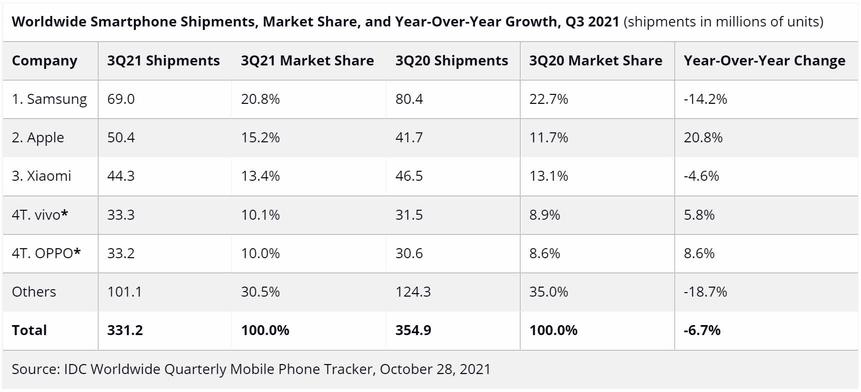Supply shortages and related snafus have finally caught up with the smartphone industry, putting a dent in the double-digit growth seen earlier in 2021. Worldwide smartphone shipments fell by 6.7% during the third quarter, dropping to 331.2 million, research firm IDC said on Friday. Though the third quarter is typically languid in advance of the holiday season, the decline was almost twice IDC’s forecast of a 2.9% descent.
SEE: 5G smartphones: A cheat sheet (TechRepublic)
In comparison, smartphone shipments surged by more than 25% in the first quarter of 2021 and by more than 13% in the second quarter, according to IDC. Fellow research firm Canalys also reported on the latest results, pegging the quarterly decrease at 6%, with total shipments coming in at 325.5 million.
IDC blamed the third-quarter downfall largely on supply chain constraints.
“The supply chain and component shortage issues have finally caught up to the smartphone market, which until now seemed almost immune to this issue despite its adverse impact on many other adjacent industries,” said Nabila Popal, research director with IDC’s Mobility and Consumer Device Trackers. “In all honestly, it was never fully immune to the shortages, but until recently the shortages were not severe enough to cause a decline in shipments and was simply limiting the rate of growth. However, the issues have now compounded, and shortages are affecting all vendors alike.”
Other factors have paused the sector’s recovery from last year’s downturn. More stringent testing and quarantining policies to combat the coronavirus pandemic have delayed the transportation of necessary parts and products. Plus, constraints of power supplies in China have limited the industry’s ability to manufacture core components.

“Despite all efforts to mitigate the impact, all major vendors’ production targets for the fourth quarter have been adjusted downwards,” Popal said. “With continued strong demand, we don’t anticipate the supply-side issues to ease until well into next year.”
The severity of the decline in shipments differed based on region. Central and Eastern Europe and Asia/Pacific (excluding Japan and China) were hit by the biggest drops at -23.2% and -11.6%, respectively. The U.S. fared much better with a dip of just -0.2%, followed by Western Europe with a -4.6% downturn, and China with a -4.4% fall.
Despite a slump in shipments, Samsung was the top vendor for the quarter with 69 million phones shipped, according to both IDC and Canalys. Shipments fell due to supply shortages of Galaxy A series devices as well as the lack of a new Galaxy Note phone, said Canalys principal analyst Ben Stanton. On the plus side, Samsung shipped more than 3 million of its foldable devices, including the Galaxy Z Flip3 and Fold3, but those results weren’t enough to boost the overall numbers.
Enjoying a healthy upturn, Apple took back the second spot as iPhone shipments jumped to around 50 million. The iPhone 13 started strong with robust pre-orders. The company also skirted past some of the constraints that hurt other smartphone vendors by using its retail stores to push sales.
“But Apple’s performance goes far beyond the iPhone 13,” said Canalys research analyst Le Xuan Chiew. “For example, it sustained the momentum of the iPhone 12 with wholesale discounting behind the scenes. It is making rapid progress with new B2B channel initiatives around the world. And it continues to curry favor with network operators, helping to drive their user bases toward 5G, and getting iPhones prioritized in their portfolios.”
Chinese vendors Xiaomi, OPPO and Vivo took home the rest of the top five spots. Xiaomi came in third even though its shipments fell for the quarter. OPPO and Vivo both scored an increase in shipments.
“Xiaomi also saw demand outstrip supply, but this was partly due to a blockbuster performance in the previous quarter, which depleted available stock,” Stanton said. “In contrast, OPPO and Vivo had a rebound in Q3 after COVID ravaged core markets in South Asia in the previous quarter.”
5G and Mobile Enterprise Newsletter
5G networks and devices, mobile security, remote support, and the latest about phones, tablets, and apps are some of the topics we'll cover.
Delivered Tuesdays and FridaysSign up today